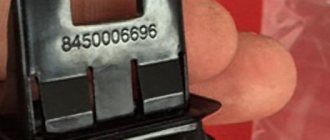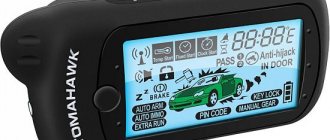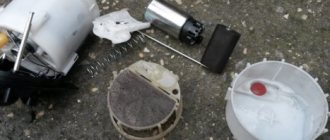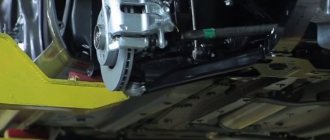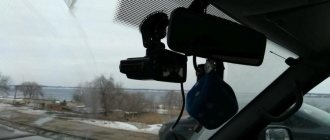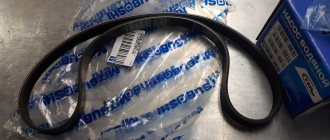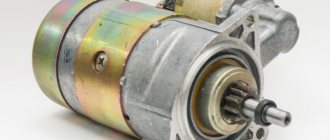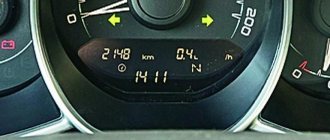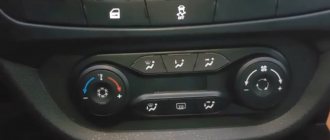The Vesta instrument cluster has a built-in trip computer (MK), which has a number of useful functions that are not found in the on-board computers (BC) of many cars (including those of competitors). For example, you can find out the voltage of the on-board network or the speed limiter. Read the instructions for using the bookmaker.
Setting the clock on the Lada Vesta on-board computer
In order to enter the clock setting mode, you need to use the top button of the on-board computer (), by long pressing this key you will get to the mode you need, how can you determine that you are already there? This is very simple, if you are on the right track, then the on-board computer should leave on its display only the numbers responsible for the current time, and one of these numbers (the first from the left) will flicker continuously. Each time digit is adjusted separately and does not depend on each other; in order to adjust the first digit, use the on-board computer buttons (,↓) with short presses. As soon as you set the first digit, move on to the next one; this can be done by long pressing the top button of the on-board computer (). Do these steps with each digit, then leave the time setting mode.
Installing a third-party computer
In the Lada Vesta model segment there are modifications that are not initially equipped with an on-board computer. Today this is not a problem, since a similar device is available for sale. The owner purchases it, and the station masters carry out the installation and connection. You can perform this activity independently, but this will require knowledge and experience.
Almost all models of on-board computers support the specified parameters, and some of them are capable of reading and displaying fault codes (errors).
Direct time setting
The time is set according to this scheme.
You need to enter edit mode . To do this, you need to press and hold the “up” arrow for about three seconds. At this moment, only the numbers “0.0 km” in the second line from the left of the display will start flashing on the screen. While in edit mode, you need to press the same arrow once. The clock indicator on the screen will blink, for example, “08:35”.
You will need to hold down the top key again for a few seconds to start changing the clock.
Only the first digit “0” from “08:35” will begin to pulsate. Now you can use the arrows to change the readings of tens, of which we only have two. To go to the hour units, hold down the “up” button again for a couple of seconds, after which “8” will begin to pulsate. Using the joystick we set the numbers we need from “0” to “9”.
Description of functions
A review of the Lada Vesta on-board computer shows which parameters are displayed on the display or front panel display. This makes the life of a Lada car enthusiast much easier. On Vesta, the standard on-board computer shows the following information, in addition to error codes:
- The magnitude of the vehicle network voltage;
- Cruising range on fuel in the gas tank;
- Current and average fuel consumption;
- Remaining fuel in the tank;
- Travel time along a specific route;
- Average speed;
- Watch;
- Total mileage;
- Controls the outside air temperature;
- Gives gear shift hints (with or without sound);
- On a Lada with cruise control, information about the installed parameters is displayed;
- If there is an AMT, the gear engaged or the auto - manual mode is displayed.
On-board computer Lada Vesta The on-board computer on the Lada Vesta is configured using two keys on the right steering column switch. Using the keys, entering the menu, you can control the readings of Vesta BC, displaying the necessary data on the control panel. Thus, the driver constantly has the opportunity to control the required parameters of Vesta.
Diagnostic options for LADA VESTA electronic control units
The Lada Vesta uses a CAN-type interface, through which signals are transmitted between vehicle systems. Problems are diagnosed using an ELM327 scanner using the OBD2 protocol. List of special functions:
- Rebooting the engine control unit, resetting cruise control, speed limits.
- Training of an automatic transmission during operation. Resetting settings.
- Adaptation of steering sensor, acceleration.
- Reset instrument panel adjustments, multimedia.
- Removing protection, initializing VIN.
- Resetting the adaptation of the power steering, speed sensor, steering angle.
Diagnosis of the ECU and CBKE on Vesta is carried out using a scanner connected to the block. To decrypt the signal, special programs are used on a PC or smartphone.
Diagnosis stages:
- Download and install one of the scanning programs.
- Carry out diagnostics of the control unit according to the adapter instructions.
- Receive and decipher codes.
- Perform adjustments or repairs to eliminate malfunctions of the device.
- Check again for errors.
Photo source: https://www.drive2.ru/l/551830318525449864/
The scanner is capable of monitoring vehicle modes and parameters while driving via OBD2.
Main functions and capabilities of the Lada Vesta head unit
Firstly, the radio tape recorder 100% fulfills its purpose - it plays music files and radio. Music can be listened to via AUX, SD card or via USB devices that can be connected as a file drive. You can also connect the radio via Bluetooth to your phone and play music on your car speakers.
Secondly, the radio displays the time on a monochrome display.
Thirdly, it has a Hands free function.
As you can see, the radio has all the necessary functions for comfortable listening to sound.
Cost of maintenance of Lada Vesta in 2021
The price for LADA Vesta maintenance may vary among dealers in different regions. It is also different for individual trim levels of the base model.
Lada Vesta in the showroom. Photo source: https://zen.yandex.ru/media/ladaonline/chto-luchshe-bazovaia-lada-vesta-ili-lada-granta-liuks-5cb312b568a9c800b4381c37
Average prices for 2021 in Moscow and the Moscow region (work only, without the cost of replacement consumables, in rubles) for Vesta sedan, station wagon, SV Cross models:
- TO-1 – 6600;
- TO-2 – 8800;
- TO-3 – 6600;
- TO-4 – 8800;
- TO-5 – 6600;
- TO-6 – 17700.
The same for the Vesta Sport model:
- TO-1 – 7100;
- TO-2 – 9200;
- TO-3 – 7100;
- TO-4 – 9200;
- TO-5 – 7100;
- TO-6 – 18200.
The cost of maintenance for a Lada Vesta from an official dealer is still less than that of its classmates produced in Russia. You can compare the cost of maintenance of 1 Lada Vesta with its analogues.
Maintenance regulations for Lada Vesta: features
Each car owner operates his car at his own individual rhythm, so it is impossible to determine a single annual mileage rate for all drivers. AvtoVAZ has set the frequency of maintenance of its cars in such a way as to take into account the interests of both those who spend most of their lives behind the wheel and those who get into the car a couple of times a week.
Maintenance of Lada Vesta. Photo source: https://www.drive2.ru/l/539417107125764692/
Therefore, the moment when it is time to go to the service for the next maintenance of the Lada Vesta was established in two ways:
- every 15 thousand kilometers;
- no later than 12 months after the previous repair.
You need to base it on what happens first.
Where is the LADA VESTA ECU located?
The ECU on the Vesta is located in the engine compartment (engine compartment).
The control housing is rigidly fixed to the vehicle frame. The wiring harness approaches the device from below and is connected through a block with latches. Due to its location under the hood, the VESTA ECU can become a target for thieves who replace the device with another. The method of protecting the unit from intruders is an additional housing made of 3 mm steel with stud fastening to the frame. The connection between the ECU and the CBKE, which is located under the dashboard to the right of the driver, in the Lada Vesta is made through a connector with 16 contacts - OBD2. The block is located in the cabin to the left of the driver's seat under the panel, near the hood lock handle. The OBD2 contact connector is an open type.
Photo source: https://www.drive2.ru/l/551817399263822806/
Diagnostics and error reset are carried out through this device using ELM327. The control unit is removed in order to flash new software using a bootloader in BLS mode.
Deactivating daytime running lights
Daytime running lights on the Lada Vesta turn on automatically - you just need to turn the ignition switch to two extreme positions. DRLs were invented in order to increase traffic safety on the road, but we must admit that even, for example, at night they shine quite brightly and are sometimes completely inappropriate.
An example of this is an alarm system with auto start. If the owner activates this mode, then at night those around him will already know that the car’s engine is running - this increases the risk of vandalism or even theft. Therefore, some owners of domestic compact cars decided to turn off the DRLs.
This is done very simply. You just need to set the steering column lever to an intermediate position between 0 and the “dimensions” label. That's it, daytime running lights will not work for us when the ignition is activated.
Did you like the article? Subscribe to the channel to stay up to date with the most interesting materials
Peculiarities
- Easily connects to the car, to work you only need to connect it to the OBD-2 diagnostic block. Has a large number of dial-up multi-displays, with a different number of displayed parameters (4, 6, 8, 12, 16) and one multi-display with automatic parameter changes depending on current conditions.
- It can separately take into account operation on gasoline and gas (LGBT mode), and also display the cost of consumed fuel.
- It produces a large number of diagnostic parameters received from the ECM controller (such as lambda value, fuel injection correction, voltage at ADC inputs) and can also control the actuators of the ECM controller.
- There is an idle control mode that allows you to set the engine speed at idle. This allows you to reduce consumption or reduce vibration at idle.
- Display of ECM errors with their status and their text decoding, as well as erasing them. Displays errors in the automatic climate control system, central body electronics system, ABS system, airbag system, AMT with their status but without text decoding, as well as erasing them.
- Displays operating parameters of the automated gearbox.
- It has the functions “Plasmer”, “Tropic”, “Fast and Furious”, and the “DYNAMICS” mode, which allows you to measure and display the dynamic characteristics of the car.
- Engine hour counting mode (under different vehicle operating conditions).
- Engine temperature indicator.

